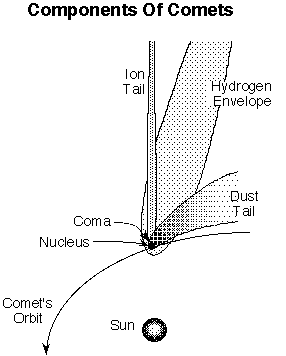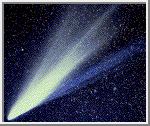 |
|---|

| Introduction |
|---|
Comets are small, fragile, irregularly shaped bodies composed of a mixture of non-volatile grains and frozen gases. They have highly elliptical orbits that bring them very close to the Sun and swing them deeply into space, often beyond the orbit of Pluto.
Comet structures are diverse and very dynamic, but they all develop a surrounding cloud of diffuse material, called a coma, that usually grows in size and brightness as the comet approaches the Sun. Usually a small, bright nucleus (less than 10 km in diameter) is visible in the middle of the coma. The coma and the nucleus together constitute the head of the comet.
 |
|---|
As comets approach the Sun they develop enormous tails of luminous material that extend for millions of kilometers from the head, away from the Sun. When far from the Sun, the nucleus is very cold and its material is frozen solid within the nucleus. In this state comets are sometimes referred to as a "dirty iceberg" or "dirty snowball," since over half of their material is ice. When a comet approaches within a few AU of the Sun, the surface of the nucleus begins to warm, and volatiles evaporate. The evaporated molecules boil off and carry small solid particles with them, forming the comet's coma of gas and dust.
When the nucleus is frozen, it can be seen only by reflected sunlight. However, when a coma develops, dust reflects still more sunlight, and gas in the coma absorbs ultraviolet radiation and begins to fluoresce. At about 5 AU from the Sun, fluorescence usually becomes more intense than reflected light.
As the comet absorbs ultraviolet light, chemical processes release hydrogen, which escapes the comet's gravity, and forms a hydrogen envelope. This envelope cannot be seen from Earth because its light is absorbed by our atmosphere, but it has been detected by spacecraft.
The Sun's radiation pressure and solar wind accelerate materials away from the comet's head at differing velocities according to the size and mass of the materials. Thus, relatively massive dust tails are accelerated slowly and tend to be curved. The ion tail is much less massive, and is accelerated so greatly that it appears as a nearly straight line extending away from the comet opposite the Sun. The following view of Comet West shows two distinct tails. The thin blue plasma tail is made up of gases and the broad white tail is made up of microscopic dust particles.

Each time a comet visits the Sun, it loses some of its volatiles. Eventually, it becomes just another rocky mass in the solar system. For this reason, comets are said to be short-lived, on a cosmological time scale. Many scientists believe that some asteroids are extinct comet nuclei, comets that have lost all of their volatiles.
| Comet Animation |
|---|
| Views of Comets |
|---|
 Comet Kohoutek
Comet Kohoutek
This color photograph of the comet Kohoutek was taken by members of the
lunar and planetary laboratory photographic team from the University of
Arizona. They photographed the comet from the Catalina observatory with
a 35mm camera on January 11, 1974. (Courtesy NASA)
 Comet Hyakutake
Comet Hyakutake
These Hubble Space Telescope images of comet Hyakutake were taken on
March 25, 1996 when the comet passed at a distance of 9.3 million miles
from Earth. These images focus on a very small
region near the heart of the comet, the icy, solid nucleus and provide
an exceptionally clear view of the near-nucleus region of the comet.
The left image is 2070 miles across (3340 km) and shows that most of the dust is being produced on the sunward-facing hemisphere of the comet. Also at upper left are three small pieces which have broken off the comet and are forming there own tails. Icy regions on the nucleus are activated as they rotate into sunlight, ejecting large amounts of dust in the jets that are faintly visible in this image. Sunlight striking this dust eventually turns it around and "blows" it into the tailward hemisphere.
The bottom-right image is an expanded view of the near-nucleus region
and is only 470 miles (760
km) across. The nucleus is near the center of the frame, but the
brightest area is probably the tip of the strongest dust jet rather
than the nucleus itself. Presumably, the nucleus surface lies just
below this bright jet.
The top-right image shows pieces of the nucleus that apparently broke off.
The image shows at least three separate objects that are probably
made up of coarse-grained dust. Large fragments of the nucleus would
not be accelerated into the tail, which appears to be the case in this
image.
(Credit: H. A. Weaver--Applied Research Corp.,
HST Comet Hyakutake Observing Team, and NASA)
 Comet 1993a Mueller
Comet 1993a Mueller
This is a CCD image of comet 1993a Mueller, taken on October 6, 1993
with a 288mm f/5.2 Schmidt-Cassegrain telescope. The comet has a coma
diameter of 3' and a fan-shaped tail, up to 7' long.
(Courtesy Erich Meyer and Herbert Raab, Austria)
 Comet West (1975)
Comet West (1975)
This photograph was taken by amateur astronomer John Loborde on
March 9, 1976. This picture shows two distinct tails. The
thin blue plasma
tail is made up of gases and the broad white tail is made
up of microscopic dust particles.
(Courtesy John Laborde)
 Comet Hale-Bopp
Comet Hale-Bopp
These NASA Hubble Space Telescope pictures of comet Hale-Bopp show a
remarkable "pinwheel" pattern and a blob of free-flying debris near the
nucleus. The bright clump of light along the spiral (above the
nucleus, which is near the center of the frame) may be a piece of the
comet's icy crust that was ejected into space by a combination of ice
evaporation and the comet's rotation, and which then disintegrated into
a bright cloud of particles.
Although the "blob" is about 3.5 times fainter than the brightest
portion at the nucleus, the lump appears brighter because it covers a
larger area. The debris follows a spiral pattern outward because the
solid nucleus is rotating like a lawn sprinkler, completing a single
rotation about once per week.